Range of Models for HSBC Bank

This diverse group of models was commissioned by HSBC bank as part of a worldwide branch refurbishment program. Designed to fit into standardized glass cabinets, the purpose of the models is to draw attention to newly created information panels featuring case studies of companies the bank has supported. Each model reflects an important element of the company’s field of business. The picture above shows four of the models in one of HSBC’s main branches in central London. So far we’ve sent dozens of sets of models to branches in cities all over the world, as far apart as Vancouver, Paris and Hong Kong (to name but a few). All the models began as concept visuals which we then developed from prototypes through to final approved designs, before going into batch production. The range comprises seven different model types and we are currently in the process of developing new model designs for three new case studies. We’re pleased to be able to say this is an ongoing project with orders coming in on a regular basis.


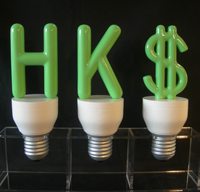
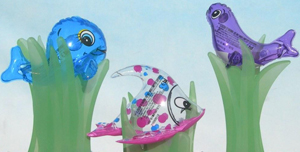



Seven different model designs
The creation of these seven very different models required a wide range of model making techniques and involved solving many technical problems along the way. The models look deceptively simple in the photos but each design had at least one technically demanding issue that needed resolving. Furthermore they had to be designed so that they could be safely shipped in cardboard boxes, be easily assembled on site, and be durable enough for long term display. Luckily this is just the sort of challenge we enjoy. With our highly skilled team and 20 years of experience behind us, we were able to turn the initial concept sketches into the eye catching models that are now on display in HSBC branches around the world.
Rain Making Exhibition Model

For this particular project we were commissioned by a subsidiary of the Dow Chemical company to design and create an exhibition model that demonstrated the unique properties of their rail-track ballast stabilization system. The key feature of the product was that it bonded the ballast together whilst still allowing free drainage between the individual stones. This free draining aspect was the product’s major advantage and the display had to illustrate this in a visual demonstration. It also had to be compact and portable as it would be travelling to exhibition venues all over the world (the electrics needed to be compatible with multinational power systems). Our solution was to create a “Rain Machine” that showed a sample of the client’s product (using clear stones rather than conventional ballast) under a continuous deluge of water, set within a Perspex tank. The clear void underneath the ballast showed the “rain water” draining freely into the collection tank below where it was pumped back up to the header tank at the top to continue the cycle. This image shows the model without the water running for clarity. Since this picture was taken branding graphics have been added and the model has gone off to its first venue in Germany. We’re hoping to add some on-site “in action” shots at a later date.
World Map Model

The purpose of this model was to show the multiple global locations of this international logistics company’s distribution depots. The model formed part of a coordinated set of information displays for their in-house visitor centre. From a very loose initial brief we helped the client pin down the specification and general appearance of the model to ensure it became an eye catching and informative centrepiece for the room. The model features detailed inset panels and a simple interactive element with button controlled illumination.
Replica of Vintage Aircraft
This is actually the final stage of a project we started in March . It’s a fibreglass replica of a crashed World War 2 seaplane, a “Vickers Supermarine Walrus” and what’s especially unusual about this model is that it is actually underwater. When the National Marine Aquarium at Plymouth decided they wanted an unusual display to put in their huge sea water tank, they avoided the obvious route of a sunken ship and went instead for this wrecked seaplane. They chose the Walrus because it had strong historical links with the area. If you visit the aquarium’s web site you can read the full story (link below). At 12 metres long and with a 14 metre wing span it was one of the biggest projects we had ever undertaken and one of the most technically demanding. Our starting point was a small set of paper plans, a photograph of a model, and some photos of the real thing at the Royal Fleet Air Arm Museum. When working out how to make it, the design process was complicated by several factors. It had to be transportable from Cardiff to Plymouth. It had to go into the aquarium through a small door three stories up the building. It had to be reassembled in a small space on top of the 9 metre deep tank. It had to sink (obviously). Divers had to be able to do the final assembly under water. And it had to be structurally sound and be able to withstand being under water for many years. Furthermore we had to design the damaged areas in a way that wouldn’t injure or trap the fish. It was a difficult project to photograph due to restricted viewing lines into the tank, but hopefully the images we’ve shown give a good indication of how the finished display looked. If you scroll down through the images below you can also get a flavour of the installation process. It was certainly a challenging but enjoyable day for us and the aquarium’s team of divers. The sharks and other fish seemed to find it pretty entertaining too.

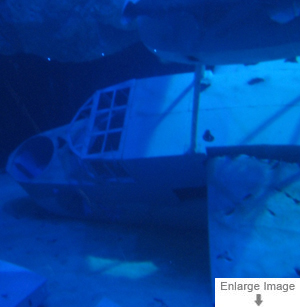
Image Gallery


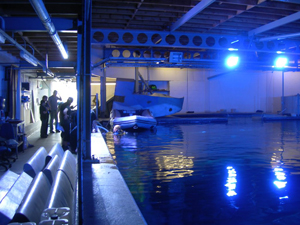







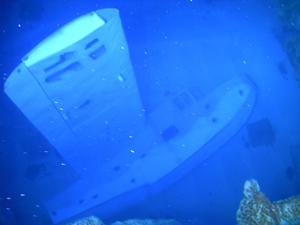






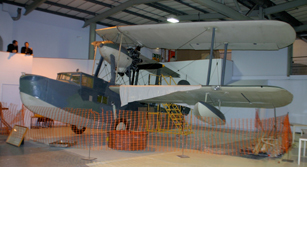
Replica of Vintage Aircraft – Scale 1:1 (actual size)
The message on my desk said “Model of a Walrus??” One of my colleagues had taken the telephone enquiry when I was out of the office and I rang the client back straightaway. It took a minute or so of confused conversation before I realised that what was needed was a life-size replica of a WW2 Walrus Seaplane rather than a model of a toothsome mammal. And then it got even more interesting. The “Walrus” was actually going to be a sunken plane-wreck in the huge seawater tank at the National Marine Aquarium in Plymouth. It was a daunting job to say the least but also an irresistible challenge and we were glad to take it on. With a 14 metre wing span and 12 metre long fuselage this is the largest fibreglass model we’ve ever undertaken and we’re only half way through it. This wing is actually just a first stage installation to generate some publicity for the whole project which is due for completion at the end of next month. By the way, it’s meant to look dirty and damaged because it is, after all, supposed to be a wreck. The wing was built in 4 main sections so we could get it in the building and to keep it manageable for the divers. One of the images shows the divers assembling it at the bottom of the tank (with an inquisitive shark for company). The other shows how the assembled wing looks from one of the main viewing windows. We should be posting images of the completed project in early June – watch this space.


